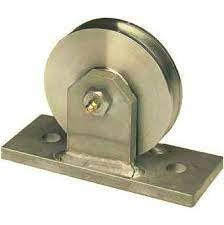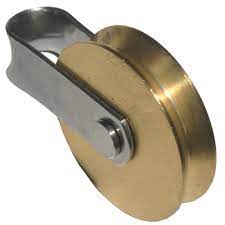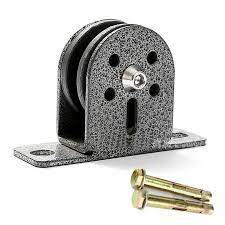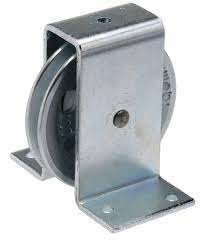Product Description
Stainless Steel SS304 Hardware Rigging wire rope rolling bearing block pulley
| Item | Wire Rope Pulley |
| Model | Single Pulley, Double Pulley |
| Size | M15-M100 |
| Material | Stainless Steel 304/316, Carbon Steel |
| Standard | DIN, ASME, BS, JIS, AS, EN, GB for option |
| Grade | A2-70, A4-80, 4.8/8.8 |
| Finish | Plain, Passivation, Polishing, Galvanized, Zinc Plated, Hot-dip Galvanized |
| Delivery Time | 3-15 days |
| OEM | Available |
Q: What's your product range?
A: Our product cover Bolts, Screws, Nuts, Washers, Spring ,Rivet, Anchor, Pulley, Rigging and so on.
Q: How long is your delivery time?
A: 3 days for stock items,7-15 days for production.
Q: How do you control your quality.
A: QC on-line inspection and final inspection before delivery. 6S management. MTC and Quality Report can be provide.
Q: Could you provide free samples?
A: Yes, we could offer free samples for the items in stock, just need to pay shipping cost, it can be refunded to your orders.
Q: Do you accept small order?
A: Sure, we can accept small orders if we have stock of the specification which you need..
Q: What is your packing ?
A: 20-25kg for 1 carton,36 or 48 cartons for 1 pallet. One pallets is about 900-960kg. Customized carton and Customer's logo is available.
Q: What is your payment term?
A: We can accept T/T, L/C for bulk order. Paypal and Western Union for small order or sample order.
Made-in-China Online payment is available.
Q: Do you accept customized order?
A: Yes, we can produce according to sample or drawing.
/* January 22, 2571 19:08:37 */!function(){function s(e,r){var a,o={};try{e&&e.split(",").forEach(function(e,t){e&&(a=e.match(/(.*?):(.*)$/))&&1
| Warranty: | 1 Year |
|---|---|
| Type: | Wire Rope Pulley |
| Material: | Stainless Steel/Carbon Steel |
| Number of sheaves: | Single Pulley, Double Pulley |
| Control: | Manual |
| Color: | Silver |
| Samples: |
US$ 0/Piece
1 Piece(Min.Order) | |
|---|
| Customization: |
Available
| Customized Request |
|---|
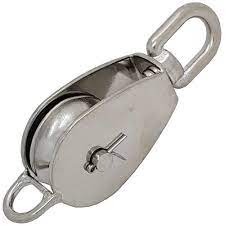
What role do rope pulleys play in outdoor adventure and sports activities?
Rope pulleys play a significant role in outdoor adventure and sports activities. Here's a detailed explanation of the role that rope pulleys play in these contexts:
1. Climbing and Mountaineering:
In climbing and mountaineering, rope pulleys are essential components of various systems. They are used for belaying, where the rope passes through a pulley attached to an anchor point, allowing for controlled movement and protection against falls. Pulleys are also used in hauling systems, enabling climbers to lift heavy loads such as gear or rescue equipment. Rope pulleys provide mechanical advantage and directional change of forces, making climbing and mountaineering safer and more efficient.
2. Ziplining and Canopy Tours:
Rope pulleys are integral to ziplining and canopy tour activities. They are used to create the pulley systems that allow participants to traverse between platforms or zip along cables. The pulleys used in these activities are specifically designed for high-speed movement and can handle significant loads. Rope pulleys provide smooth and controlled gliding experiences, enhancing the thrill and enjoyment of ziplining and canopy tours.
3. Rope Courses and Challenge Courses:
Rope pulleys are extensively used in rope courses and challenge courses. These activities involve traversing obstacles and elements using ropes and cables. Rope pulleys are employed to create the necessary belay systems, allowing participants to move safely through the course. They provide the mechanical advantage and control required for participants to navigate challenging terrain and complete the course with confidence.
4. Caving and Speleology:
In caving and speleology, rope pulleys are vital for vertical or horizontal cave exploration. They are used in ascending and descending systems, allowing cavers to safely navigate steep or vertical sections of caves. Rope pulleys enable controlled movement and help distribute the load, reducing fatigue and strain on the caver. They are designed to withstand rugged environments and provide reliable performance in challenging underground conditions.
5. Sailing and Boating:
Rope pulleys, known as blocks, are extensively used in sailing and boating activities. They are employed to create mechanical advantage systems for hoisting sails, adjusting rigging, and controlling various lines on a boat. Rope pulleys allow sailors to manage the forces exerted by wind and water, making sail handling and maneuvering more efficient. They contribute to the overall performance and safety of sailing and boating experiences.
6. Rescue and Emergency Situations:
In rescue and emergency scenarios, rope pulleys play a crucial role. They are used in systems such as rope rescue, high-angle rescue, and swiftwater rescue. Rope pulleys enable rescuers to efficiently lift and lower victims, perform technical rope maneuvers, and create mechanical advantage systems for complex rescue operations. They enhance the safety and effectiveness of rescue efforts in challenging environments.
In conclusion, rope pulleys are indispensable in outdoor adventure and sports activities. They provide mechanical advantage, control, and efficient force transmission, enabling participants to navigate obstacles, traverse terrain, and handle loads with ease. Rope pulleys contribute to the safety, performance, and enjoyment of various outdoor adventure pursuits, including climbing, ziplining, rope courses, caving, sailing, and rescue operations.

How do rope pulleys play a role in industrial applications, such as material handling?
Rope pulleys play a significant role in industrial applications, particularly in material handling processes. Here's a detailed explanation of their role in such settings:
1. Lifting and Moving Heavy Loads:
Rope pulleys are commonly used in industrial settings to lift and move heavy loads. By utilizing a combination of fixed and movable pulleys, mechanical advantage is achieved, allowing workers to lift and move loads that would otherwise be too heavy to handle manually. This is especially useful in industries such as construction, manufacturing, and logistics, where large and heavy materials or equipment need to be transported or positioned.
2. Load Distribution:
In material handling applications, it is often necessary to distribute the load across multiple points to ensure stability and safety. Rope pulleys are employed in systems like block and tackle setups to evenly distribute the load between multiple ropes and pulleys. This helps in maintaining balance, reducing the strain on individual ropes, and ensuring that the load is handled securely. Load distribution is particularly crucial when dealing with irregularly shaped or fragile items that require careful handling.
3. Directional Changes:
Rope pulleys are used to change the direction of the force applied to the rope. In industrial applications, this is valuable for redirecting materials or equipment along a desired path. By incorporating pulleys at strategic points, workers can guide loads through complex routes, around obstacles, or through confined spaces. The ability to change the direction of movement enables efficient material flow, optimizing productivity and minimizing the need for manual handling in challenging environments.
4. Height Adjustment:
In industrial settings, there are often requirements to adjust the height of equipment or platforms. Rope pulleys, combined with mechanisms like counterweights or winches, are utilized to facilitate smooth and controlled height adjustment. This is commonly seen in applications such as theater rigging, where stage sets or lighting equipment need to be raised or lowered, or in warehouses where adjustable platforms are used for loading and unloading operations.
5. Safety Considerations:
Rope pulleys play a crucial role in ensuring safety in industrial material handling. By utilizing appropriate pulley systems and adhering to safety guidelines, the risk of accidents and injuries can be minimized. Pulleys with self-locking mechanisms or progress capture features are often employed in applications where loads need to be held securely in position, preventing accidental slippage or release.
6. Ergonomics and Efficiency:
Efficient material handling is essential in industrial operations to optimize productivity and reduce strain on workers. Rope pulleys help improve ergonomics by reducing the physical effort required to move heavy loads. By leveraging the mechanical advantage provided by pulley systems, workers can perform tasks more easily and with less risk of fatigue or injury, leading to increased efficiency and productivity.
In summary, rope pulleys play a vital role in industrial applications, especially in material handling. They enable the lifting and movement of heavy loads, assist in load distribution, facilitate directional changes, allow for height adjustment, enhance safety measures, and contribute to ergonomic and efficient operations. By utilizing appropriate pulley systems, industrial processes can be streamlined, productivity can be enhanced, and the well-being of workers can be prioritized.

How do rope pulleys assist in lifting and moving heavy objects?
Rope pulleys play a vital role in lifting and moving heavy objects by providing mechanical advantage and changing the direction of applied forces. Here's a detailed explanation of how rope pulleys assist in lifting and moving heavy objects:
1. Mechanical Advantage:
Rope pulleys provide a mechanical advantage, allowing users to exert less effort when lifting heavy objects. The mechanical advantage is achieved by distributing the weight of the load across multiple ropes and pulleys in a system. By increasing the number of pulleys or using a combination of fixed and movable pulleys, the mechanical advantage can be further enhanced. This redistribution of forces reduces the amount of force required by the user to lift or move the object, making it more manageable.
2. Directional Change of Forces:
Rope pulleys change the direction of the applied forces, enabling users to lift or move objects in a desired direction. When a rope is threaded through a pulley and attached to a load, pulling the rope downward results in an upward force on the load. This redirection of forces allows for vertical lifting as well as horizontal movement. By incorporating multiple pulleys and changing the arrangement of the ropes, the direction of forces can be adjusted to suit the specific lifting or moving requirements.
3. Increased Control and Precision:
Rope pulleys offer increased control and precision when lifting and moving heavy objects. The pulleys allow for smooth and controlled movement, minimizing jerks or sudden shifts that could potentially damage the load or cause accidents. This control is particularly important when dealing with delicate or fragile objects. By using rope pulleys, users can adjust the tension and movement of the ropes, ensuring a controlled and gradual lift or movement of the load.
4. Versatility and Adaptability:
Rope pulleys are versatile and adaptable tools for lifting and moving heavy objects. They can be used in a wide range of scenarios and environments, including construction sites, shipping yards, theaters, and recreational activities. Rope pulleys can accommodate different types of ropes or cables, allowing users to select the appropriate material and strength based on the specific requirements of the task. This versatility makes rope pulleys suitable for various applications and ensures efficient and safe lifting and movement of heavy objects.
5. Reduced Physical Strain and Risk of Injury:
By providing mechanical advantage and changing the direction of forces, rope pulleys help reduce the physical strain on users when lifting and moving heavy objects. This reduction in physical effort decreases the risk of fatigue, muscle strain, and potential injuries. Rope pulleys allow individuals to leverage their strength effectively and utilize proper lifting techniques, promoting safer working practices and minimizing the likelihood of accidents.
In conclusion, rope pulleys assist in lifting and moving heavy objects by providing mechanical advantage, changing the direction of forces, offering increased control and precision, and reducing physical strain and the risk of injury. Their design and functionality make them essential tools in various industries and scenarios where the efficient handling of heavy loads is required.


editor by CX
2024-05-15

